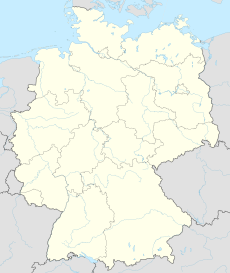
Back Pont de Remagen Catalan Ludendorff-Brücke German Puente de Remagen Spanish Pont de Remagen French גשר לודנדורף HE Ponte Ludendorff Italian ルーデンドルフ橋 Japanese 루덴도르프 교 Korean Ludendorffbrug Dutch Most Ludendorffa Polish
This article includes a list of general references, but it lacks sufficient corresponding inline citations. (June 2016) |
Ludendorff Bridge Ludendorff-Brücke | |
|---|---|
 The bridge seen from the bank of the Rhine before its March 1945 collapse | |
| Coordinates | 50°34′45″N 7°14′39″E / 50.5792°N 7.2442°E |
| Carried | Railway |
| Crossed | Rhine |
| Locale | Rhineland-Palatinate |
| Official name | Ludendorff Bridge |
| Other name(s) | Bridge at Remagen |
| Named for | Erich Ludendorff |
| Characteristics | |
| Design | Through arch bridge |
| Material | Iron |
| Total length | 325 m (1,066 ft) |
| Piers in water | Two |
| History | |
| Designer | Karl Wiener |
| Constructed by | Grün & Bilfinger |
| Construction start | 1916 |
| Construction end | 1919 |
| Construction cost | 2.1 million marks |
| Collapsed | 17 March 1945 |
| Location | |
 | |
The Ludendorff Bridge (sometimes referred to as the Bridge at Remagen) was a bridge across the river Rhine in Germany which was captured by United States Army forces in early March 1945 during the Battle of Remagen, in the closing weeks of World War II, when it was one of the few remaining bridges in the region and therefore a critical strategic point. Built during World War I to help deliver reinforcements and supplies to German troops on the Western Front, it connected Remagen on the west bank and the village of Erpel on the east bank between two hills flanking the river.
Midway through Operation Lumberjack, on 7 March 1945, the troops of the 1st U.S. Army approached Remagen and were surprised to find that the bridge was still standing.[1] Its capture, two weeks before Field Marshal Bernard Montgomery's planned Operation Plunder, enabled the U.S. Army to establish a bridgehead on the eastern side of the Rhine. After the U.S. forces captured the bridge, German forces tried to destroy it many times.
It finally collapsed on 17 March 1945, 10 days after it was captured; 28 Army engineers were killed in the collapse while a further 63 were injured. Of those who died, 18 were actually missing, but presumably had drowned in the swift current of the Rhine.[2] The bridge, while it stood, and newly established pontoon bridges, enabled the U.S. Army to secure a bridgehead of six divisions, about 125,000 troops, with accompanying tanks, artillery pieces, and trucks, across the Rhine. Capturing the bridge hastened the war's conclusion,[3] and V-E Day came on May 8. After the war, the bridge was not rebuilt; the towers on the west bank were converted into a museum and the towers on the east bank are now a performing-arts space.
A 2020 poll of local people found that 91% favoured rebuilding the bridge; without it there is no river crossing for 44 km (27 mi), and few ferries. In 2022 plans were initiated to build a suspension bridge for pedestrians and cyclists. Local communities indicated an interest to help fund the project and an engineer was commissioned to draw up plans.[4]
- ^ Cite error: The named reference
Shirerwas invoked but never defined (see the help page). - ^ "Battle of the Remagen Bridgehead". www.usace.army.mil. March 2020.
- ^ The Bridge. Beyreuth, Germany: 9th Armored Infantry Division.
- ^ Connolly, Kate (19 September 2022). "Germany to rebuild bridge over Rhine that collapsed during WW2". The Guardian.
